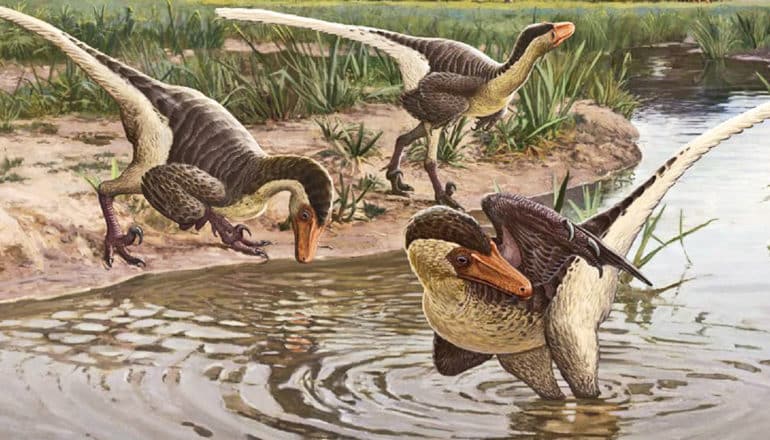
Dineobellator notohesperus, a newly discovered feathered dinosaur that lived in New Mexico 67 million years ago, is one of the last known surviving raptor species, according to new research.
The dinosaur adds to scientists’ understanding of the paleo-biodiversity of the American Southwest, offering a clearer picture of what life was like in this region near the end of the reign of the dinosaurs.
In 2008, Robert Sullivan of the New Mexico Museum of Natural History and Science in Albuquerque found fossils of the new species in Cretaceous rocks of the San Juan Basin in New Mexico. He and his field team collected the specimen on US federal land under a permit from the Bureau of Land Management. The team recovered the entire specimen over four field seasons.
Steven Jasinski, a member of the field team who recently completed his PhD in the Earth and environmental sciences department at the University of Pennsylvania, and his coauthors gave the species its official name, Dineobellator notohesperus. The name means “Navajo warrior from the Southwest,” in honor of the people who today live in the same region where this dinosaur once lived.
Dineobellator, as well as its Asian cousin Velociraptor, belong to a group of dinosaurs known as the dromaeosaurids. Researchers commonly refer to members of this group as “raptor” dinosaurs, thanks to movies such as Jurassic Park and Jurassic World.
But unlike the terrifying beasts depicted in film, Dineobellator notohesperus stood only about 3.5 feet (about 1 meter) at the hip and was 6 to 7 feet (about 2 meters) long—much smaller than its Hollywood counterparts.
Raptor dinosaurs are generally small, lightly built predators. Consequently, their remains are rare, particularly from the southwestern United States and Mexico.
“While dromaeosaurids are better known from places like the northern United States, Canada, and Asia, little is known of the group farther south in North America,” Jasinski says.
While the researchers did not recover all of the bones of this dinosaur, bones from the forearm have quill nobs—small bumps on the surface where feathers would be anchored by ligaments—an indication that Dineobellator bore feathers in life, similar to those inferred for Velociraptor.
Features of the animal’s forelimbs, including enlarged areas of the claws, suggest this dinosaur could strongly flex its arms and hands. This ability may have been useful for holding on to prey—using its hands for smaller animals such as birds and lizards, or perhaps its arms and feet for larger species such as other dinosaurs.
Its tail also possessed unique characteristics. While most raptors’ tails were straight and stiffened with rod-like structures, Dineobellator’s tail was rather flexible at its base, allowing the rest of the tail to remain stiff and act like a rudder.
“Think of what happens with a cat’s tail as it is running,” says Jasinski. “While the tail itself remains straight, it is also whipping around constantly as the animal is changing direction. A stiff tail that is highly mobile at its base allows for increased agility and changes in direction, and potentially aided Dineobellator in pursuing prey, especially in more open habitats.”
This new dinosaur provides a clearer picture of the biology of North American dromaeosaurid dinosaurs, especially concerning the distribution of feathers among its members.
“As we find evidence of more members possessing feathers, we believe it is likely that all the dromaeosaurids had feathers,” says Jasinski. The discovery also hints at some of the predatory habits of a group of iconic meat-eating dinosaurs that lived just before the extinction event that killed off all the dinosaurs that weren’t birds.
Jasinski plans to continue his field research in New Mexico with the hope of finding more fossils.
“It was with a lot of searching and a bit of luck that this dinosaur was found weathering out of a small hillside,” he says. “We do so much hiking and it is easy to overlook something or simply walk on the wrong side of a hill and miss something. We hope that the more we search, the better chance we have of finding more of Dineobellator or the other dinosaurs it lived alongside.”
The research appears in the journal Scientific Reports.
Additional researchers are from the University of Pennsylvania and the New Mexico Museum of Natural History. Geo. L. Harrison and Benjamin Franklin fellowships supported Jasinski. Funding for the research came from, in part, a Walker Endowment Research Grant and a University of Pennsylvania Paleontology Research Grant.
Source: University of Pennsylvania
The post Feathery dino from New Mexico was one of the last raptors appeared first on Futurity.
from Futurity https://ift.tt/2UEYvK4
No comments:
Post a Comment